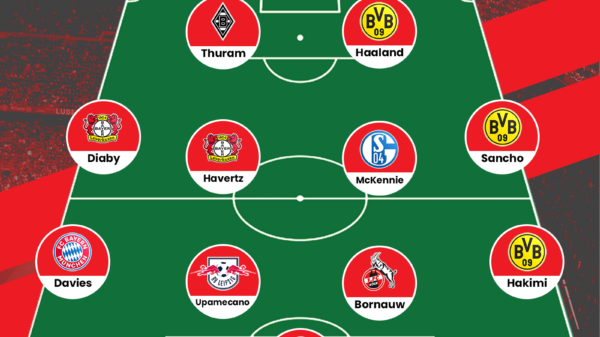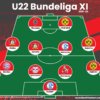Lucien Favre’s Borussia Monchengladbach were a breath of fresh tactical air last season in the Bundesliga. Their start to this season has been far from spectacular though. However, ahead of Borussia Monchengladbach’s Champions League campaign, Ross Eaton ponders whether their tactics are suited to Europe’s biggest competition.
It’s the 23rd May 2015 and Lucien Favre’s Borussia Monchengladbach go into their final match of the season, against Augsburg. The fans are in high spirits and rightly so, the Foals have secured 3rd place in the Bundesliga, the club’s best finish since 1987, and will
automatically qualify for Champions League.
On the back of such a successful season, it’s come as a slight shock that in their opening three games of the new season, Monchengladbach have picked up 0 points. With the
Champions League group stages on the horizon, BMG will have to improve, and quickly. Manager Lucien Favre has no experience of the Champions League and
Gladbach have had a poor start domestically, but we believe they are suitably prepared for the Champions League.
Last season in Europe’s top five leagues, just Barcelona, Bayern Munich and Juventus conceded less than Monchengladbach. All three of these sides,(in their domestic leagues at least), play in a high block and like to press the opponent high up the pitch, causing errors which then instantly lead to attacks which are only a pass or two away from creating a chance. However Gladbach are different to these three, Gladbach lie in a deep block, preferring to defend in their own half, not pressing much just focusing on limiting space for the opposition. Rather than shutting up shop when defending in a deep block, Favre’s side allow shots from distance, this is a sign of them not preventing chances altogether but limiting the quality of the chances instead.

Above we can see that it took an average of 20.1 shots against Gladbach to score, almost 4 more than closest rivals to this stat, Juventus. Although it took many shots to score against BMG, this didn’t mean that they stopped shots, the Foals conceded an average of 15.4 shots per game, the sixth most in Europe’s top five leagues. This is a good indication of Gladbach‘s defensive system, it displays how they allow plenty of shots but rarely clear cut chances.
Analysing the Defensive System
As previously mentioned, Gladbach sit in a deep block, preferring to defend in their own territory rather than try to gain ground in the opposition half. Gladbach‘s basic shape is a 4-4-2, however Raffael often drops slightly deeper making a 4-4-1-1.
As we can see in the image, Gladbach are very compact both horizontally and vertically, but particularly horizontally.
The 4-4-2 went out of fashion for around 4 years, from 2009 to 2013 but we saw a return between the end of the 2012/13 season and the start of the 2013/14 season. The reason for the 4-4-2 going out of fashion was due to a number of teams looking to play a game similar to Pep Guardiola’s Barcelona. Many teams began fielding three central midfielders, which obviously left the opposition’s two centre midfielders outnumbered. In an attempt to prevent the opposition’s numerical superiority, 4-2-3-1 became the standard formation,this made sense as it did its job (prevent being outnumbered centrally) but could also change quickly into a 4-4-2 situationally, with the central player in the three moving up alongside the striker. A few years later though, the 4-2-3-1 hype has died down and
4-4-2 was reborn. A new way of preventing central overloads was to be horizontally compact, as we can see in the above image by Monchengladbach. This allows the opposition space out wide but by laterally moving to the ball-side, this can stop the opposition getting a large space to drive into on the wing.
Gladbach‘s only players who venture from their position by a large extent are their strikers,Raffael and
Max Kruse in the above image. However Kruse has now moved to Wolfsburg so Andre Hahn will be up top with Raffael this season. The strikers half-heartedly press centrally and in the halfspaces, they also attempt to block passing lines to prevent passes in between their lines.
Gladbach‘s Attacking Phase
In BMG’s attacking phase is when they begin to look far more like a stereotypical German team. Gladbach‘s attacks are centred around aggressive,vertical passes with players running in behind.
Gladbach‘s shape doesn’t vary much in the transition from defence to attack, the wingers push up alongside the forwards to make a 4-2-4 formation, this makes transitions quick and easy for
Favre’s team. A key player in
Gladbach‘s build-up is actually goalkeeper Yann Sommer. Sommer’s distribution is the trigger for movements by
Gladbach‘s midfield. If Sommer shapes to play a long pass forward, Raffael will get in a position where he can play off of Max Kruse(now Hahn), the wingers will begin runs in behind the opposition full-backs and either Kramer or Xhaka, more frequently Kramer, will move slightly further forward, closer to a number 8 position rather than 6.
When Sommer plays long balls in behind the opposition defence, he plays the pass into areas where the opposition goalkeeper wouldn’t be able to sweep meaning the defence are in a one-on-one foot race with the winger, a battle the winger usually expects to win. If Sommer plays a pass into Kruse/Hahn, Raffael should already be in a good position to play off him, this allows Kruse/Hahn to lay the ball off to Raffael who may have time on the ball due to the quick transition.
A strong element of Favre’s side tactically is that they can mix their build-up up a bit. Rather than relying on Sommer to play long passes, Xhaka and Kramer often drop even deeper than the 6 positions, almost in centre-back areas and offer a short passing option. They then have the choice to carry the ball forward or play a vertical pass, often a high diagonal to a winger.
Are Gladbach‘s tactics are suited to the Champions League?
Previously in the Champions League, minnows were known to sit back and defend, looking for a 0-0 draw at best and come away with a crucial point. Nowadays, smaller teams ‘have a go’ far more often. Recently in the Champions League, Schalke had a real go in both legs against giants Real Madrid, losing 2-0 at home but coming away from the Santiago Bernabeu with a 4-3 win, scraping out of the Cup but nonetheless showing what can happen if you ‘have a go’. Although Gladbach aren’t exactly a ‘minnow’, they aren’t a giant either and with teams such as Manchester City in their group, Gladbach may have to employ a tactical surprise to defeat a big name…or do they? With Gladbach‘s solidity and focus on their defensive work, bigger names may struggle to break down their compact shape. This in turn may lead to teams throwing everything and everyone at the Foals, thus giving a perfect opportunity for a vertical pass to the striker, a lay-off to Raffael who would then have time to attack the opponent’s goal due to the opposition being caught out of position, a classic counter-attack.
Written by Ross Eaton
Ross Eaton is a Scottish analyst looking to find a full-time career in football analysis. Ross is a believer in a short-passing but fast, attacking style of play, this would correctly suggest his favourite manager may be someone named Pep Guardiola. Take a look at Ross' personal blog at http://boxtoboxcentreback.wordpress.com/.
Latest posts by Ross Eaton
(see all)




























































